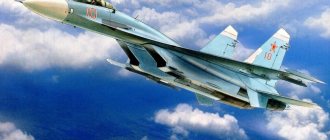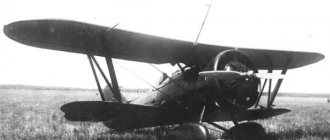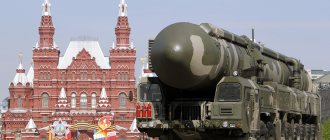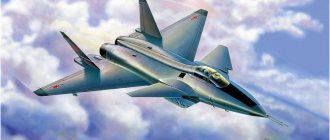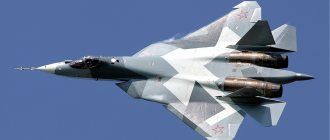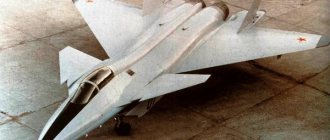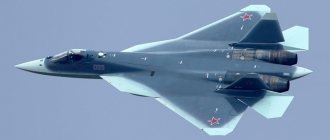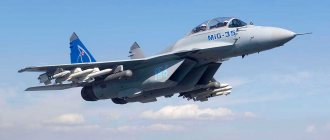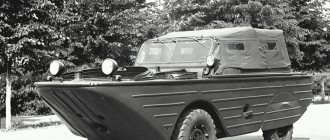Su-27 aerobatic team "Russian Knights" |
multi-role highly maneuverable all-weather fighter Su-27 (NATO designation: Flanker, “Flanker”) was originally created as an interceptor for the USSR air defense forces as a response to the US development of the new F-15 Eagle fighter. The main “specialization” of the Su-27 fighter is gaining air superiority.
Photos
History of creation
3.1 Start of development
In the late 60s, several countries began developing fourth-generation fighters. The pioneers in this were the United States of America, which in 1974 produced the F-15B and 15A “Eagle” fighters.
The Soviet Union responded to this by opening a competition for the development of a promising front-line fighter, in which three design bureaus took part. At first, Sukhoi's experimental design bureau did not participate in the project, as it was busy with other developments. But in 1969, the Sukhoi Design Bureau completed initial studies on promising front-line fighters, and two years later work began on the T-10 product. Since not everyone liked the idea of an integral layout of a glider with a delta wing, approximately 15 models, differing from each other in layout, were tested in a wind tunnel at the Central Aerohydrodynamic Institute. After this, there was a return to the first project, but at the same time the development of an aircraft with a conventional design, a two-fin high-wing aircraft with air intakes located on the sides, began. This option began to be considered due to the airframe layout of the F-15, USA.
After all, the fighter being created was mainly required to ensure supremacy in the sky, and in this it will be competed with by this glider, which will also become its probable adversary.
The combat tactics in the sky also included close maneuver combat, which was the main element of the combat use of the aircraft.
In 1972, the Yak-45 and Yak-47 projects dropped out of the competition. The MiG design bureau proposed to produce a section of the program for a promising front-line fighter and simultaneously work on light and heavy aircraft with the greatest unification of equipment, which would make the production process less expensive and faster. Also, light and heavy fighters will be given their own range of tasks.
3.2 Adoption
The T-10S fighter began serial production in 1981 at plant 126 (Komsomolsk-on-Amur). The Su-27 began to enter service unofficially in 1982, and officially eight years later, after the deficiencies discovered during testing were corrected. By this time, the fighters had already been in use for over five years. In air defense aviation, the Su-27 was designated Su-27P, interceptor, and in the air force - Su-27S, serial. The interceptor could not shoot at targets on the ground due to the fact that it had simpler equipment.
Weapons and equipment
The N001 pulse-Doppler airborne radar station has a quantum optical-location station equipped with a 36Sh laser rangefinder, capable of tracking targets in simple weather conditions with high accuracy. The radar also has a Cassegrain antenna with a diameter of 1076 mm, which can find targets on the ground and in the air with active interference. The optical location station has the ability to track a target while not far from it, without violating the fighter’s camouflage and not emit radio emissions. Data from the optical-location and airborne radar stations goes to the display frame on the windshield and the line-of-sight indicator.
4.1 Air-to-air mode
For air targets, with a minimum speed of 210 km/h, with a probability of 0.5, the minimum difference between the carrier and the target is 150 km/h.
- Target detection range: fighter class (effective scattering area - 3 m² at average altitude, over 1000 m), ZPS - 25 - 35 km, PPS - 80 - 100 km, 150 km when operating in long-range detection mode
- Finding up to ten targets
- Hit one target
- Guiding up to two missiles at one target
4.2 Air-to-ground mode (only for Su-30, Su-27SM)
- Surface mapping is possible: detection of targets over water and on the ground in mapping mode with synthetic antenna aperture with high and medium resolution, real beam mapping mode, moving targets in their selection mode. Measurement and tracking of coordinates on the ground.
- Detection in the selection mode of moving targets of a tank with an effective dispersion area of 10 m² or more, moving at 15-90 km/h
- Detection range, km: aircraft carrier - 350, effective dispersion area (RCS) - 50,000 m²; missile boat - 50-70, EPR - 500 m²; destroyer - 250, ESR - 10,000 m²; boats – 30, EPR – 50 m²; railway bridge – 100, EPR – 2000 m².
- MTBF 200 hours.
Modifications
- Su-27S (Su-27) (Flanker-B) is the main production modification, a single-seat fighter-interceptor of the Air Force.
- Su-27SK (1991) – export version of the single-seat Su-27 (Su-27S).
- Su-27SM (2002) - modernization. It mainly affected the fighter's weapons control system.
- Su-27SM3 - based on the backlog of export Su-27K, 12 aircraft were produced. The main changes are as follows: the airframe has been strengthened, AL-31F-M1 engines with a thrust of 13,500 kgf have appeared, and there are additional suspension points.
- Su-27SKM (2002) - a variant of the Su-27SM for sale to foreign countries. Its characteristics are similar to the Su-30MK2, Su-30MKK.
- The Su-27P is a single-seat interceptor fighter designed for air defense forces. It only shoots down air targets.
- Su-27UB (T-10U) (Flanker-S) is a two-seat combat training fighter. Necessary for training to fly the Su-27; in its nose there is a radar station N001 radar. Produced since 1986.
- Su-30 (Su-27PU) is a two-seat target acquisition and guidance aircraft. Based on the Su-27UB. Four Su-27 interceptors can be targeted simultaneously.
- Su-27UBK is a variant of the Su-27UB for sale to foreign countries.
- Su-33 (T-12, Su-27K) (Flanker-D) is a carrier-based single-seat fighter with folding wings. Produced since 1992.
- Su-33UB (T-12UB, Su-27KUB) is a carrier-based combat training fighter. Features a side-by-side seat arrangement.
- Su-34 (Su-32FN, Su-27IB) (Fullback) is a two-seat fighter-bomber in which the seats are in a shoulder-to-shoulder position. Necessary for firing at surface or ground targets with a high degree of security at any time of the day. All-weather. The functionality is the same as that of the US-made F-15E fighter. The first flight was carried out in the spring of 1990.
- Su-35S (Su-35BM) (Flanker-E+) is a multi-role fighter. Unlike the Su-27M, it has thrust vectoring engines and no horizontal tail surface.
5.1 Ukrainian modifications
- Su-27UB1M - modernization of the Su-27UB.
- Su-27UP1M - modernization of the Su-27UP.
- Su-27S1M - modernization of the Su-27S.
- Su-27P1M - modernization of the Su-27P.
Master of Aerobatics
The Su-27 fighter officially entered service on August 23, 1990. By that time, after five years of operation, the “twenty-seventh” had already managed to set a world record for rate of climb. In 1986, test pilot Viktor Pugachev reached an altitude of 3000 meters in just 25.4 seconds.
Literally three years later, Viktor Pugachev would surprise again: at the Le Bourget air show in June 1989, on a Su-27, he demonstrated a new aerobatic maneuver - dynamic braking, which was later nicknamed “Pugachev’s Cobra”. In flight, the plane sharply lifts its nose, flies tail first for a while, and then quickly returns to a horizontal position. This not only looks extremely impressive, but also has very practical applications in air combat. For example, a “cobra” can save you from missiles with radar homing heads, as it implies a sharp reduction in speed in combat. The maneuver can also be used to evade enemy pursuit.
After the premiere in Le Bourget, Su-27 aircraft more than once became participants in the most prestigious air shows in the world - since 1991, pilots of the Russian Air Force aerobatic team “Russian Knights” have been showing their skills in the sky. By the way, this is the only air group in the world that performs group aerobatics on heavy fighter class aircraft.
Some spectacular aerobatics were first performed on the Su-27 and were named after our pilots. In addition to the Pugachev Cobra, one of these maneuvers was the Frolov Chakra, first performed by test pilot Evgeniy Frolov on the Su-37, which is, in fact, an improved Su-27M.
The Su-27's performance of the most complex aerobatic maneuvers ensured the introduction of a new control system. It is believed that one of the main differences between fourth-generation and third-generation machines is the presence of a fly-by-wire control system (EDCS). Thus, the Su-27 became the first Russian fighter equipped with an EDSU. Replacing steel cables with electrical signals made the aircraft extremely maneuverable and at the same time stable in flight.
The highest maneuverability of the “twenty-seventh” and its ability to deliver a surprise strike were also appreciated by Western experts - according to NATO codification, the Su-27 is named Flanker (“flank striker”).
Experimental aircraft
- T-10 - prototype.
- T-10S is an improved prototype.
- Su-27 is a pre-production version equipped with AL-31 engines.
- The Su-27IB is a prototype of the two-seat fighter-bombers Su-34 and Su-32FN, in which the seats are side by side. Necessary for firing at surface or ground targets with a high degree of security at any time of the day. All-weather. The first flight was carried out in the spring of 1990.
- P-42 (T-10-15) - converted from Su-27. In the second half of the 80s, they set 41 world records for flight altitude and rate of climb, registered by the Fédération Aéronautique Internationale. The weight has been reduced quite significantly (the maximum take-off weight is 14.1 tons), and uprated engines have also appeared.
- Su-27M (T-10M) (Flanker-E) is a multi-role fighter. The power of the PGO and radar has been increased. It was exported under the designation Su-35. The Su-35 has slightly changed equipment and design depending on the specific customer.
- Su-35UB (T-10UBM) is a combat training aircraft based on the Su-27M, Su-30 and Su-37. Produced in one copy.
- Su-37 (T-10M-11) (Flanker-F) is a multi-role fighter with engines equipped with a thrust vector control system or, in short, UVT b/n 711. Based on the Su-27M with PGO. One aircraft produced.
AL-31F: the best engine for the best aircraft
The presence of an electronic thrust control system, a new radar, an optical-electronic targeting system, and advanced weapons allowed the Su-27 to become the best of its time. But gaining air superiority would have been impossible without the powerful AL-31F engine.
This engine, developed by Arkhip Lyulka, is still recognized today as one of the best in the world for front-line aircraft. It is installed not only on the Su-27, but also on its modifications, Su-33 carrier-based fighters, Su-35, Su-30MK multirole fighters, and Su-34 front-line bombers. The unique AL-31F has considerable reserves for development, the designers believe.
UEC-Saturn continued work on creating a deeply modernized version of the AL-31F. The fifth generation fighter Su-57 was equipped with the engines of the first stage - AL-41F1 (product 117). This aviation turbojet engine allows you to reach supersonic speed without using afterburner.
Comparative performance characteristics
9.1 Technical specifications
- Crew, people: project (T10-1), Su-27P(S), Su-27SK, Su-27SM – 1; Su-27UB - 2
- Length, m: project (T10-1) - 18.5; Su-27P(S), Su-27SK, Su-27SM, Su-27UB - 21,935
- Wing span, m: project (T10-1) - 12.7; Su-27P(S), Su-27SK, Su-27SM, Su-27UB - 14,698
- Height, m: project (T10-1) - 5.2; Su-27P(S), Su-27SK, Su-27SM - 5,932; Su-27UB - 6,537
- Wing area, m²: project (T10-1) – 48; Su-27P(S), Su-27SK, Su-27SM, Su-27UB - 62.04
- Wing aspect ratio: project (T10-1) - 3.38; Su-27P(S), Su-27SK, Su-27SM, Su-27UB - 3.5
- Wing taper coefficient: project (T10-1) - 6.57; Su-27P(S), Su-27SK, Su-27SM, Su-27UB - 3.4
- Sweep angle: project (T10-1) - 45°; Su-27P(S), Su-27SK, Su-27SM, Su-27UB - 42°
- Chassis base, m: project (T10-1) – no data; Su-27P(S), Su-27SK, Su-27SM, Su-27UB - 5.8
- Chassis track, m: project (T10-1) - 1.8; Su-27P(S), Su-27SK, Su-27SM, Su-27UB - 4.34
- Empty weight, t: project (T10-1), Su-27SM - no data; Su-27P(S) – 16.3; Su-27SK – 16.87; Su-27UB – 17.5
- Normal take-off weight, t: project (T10-1) – 18; Su-27P(S) - 22.5; Su-27SK - 23.4; Su-27SM - 23.7; Su-27UB - 24
- Maximum take-off weight, t: project (T10-1) – 21; Su-27P(S) – 30; Su-27SK, Su-27SM – 33; Su-27UB - 30.5
- Fuel mass, kg: project (T10-1) – no data; Su-27P(S), Su-27SK - 9,400/5,240; Su-27SM, Su-27UB - 9,400/6,120
- Fuel volume, l: project (T10-1) – no data; Su-27P(S), Su-27SK - 11,975/6,680; Su-27SM, Su-27UB - 11,975/7,800
- Powerplant: two AL-31F turbofan engines
- Non-afterburning thrust, kgf (*10 N): project (T10-1) - no data; Su-27P(S), Su-27SK, Su-27SM, Su-27UB – two for 7,600
- Afterburner thrust, kgf (*10 N): project (T10-1) – two per 10,300; Su-27P(S), Su-27SK, Su-27SM, Su-27UB - two for 12,500
9.2 Flight characteristics
- Maximum speed at an altitude of 11000 m, km/h: project (T10-1), Su-27P(S), Su-27SK, Su-27SM - 2,500 (M=2.35); Su-27UB - 2,125 (M=2.0)
- Maximum ground speed, km/h: project (T10-1) - 1,400; Su-27P(S), Su-27SK, Su-27SM, Su-27UB - 1,380
- Landing speed, km/h: project (T10-1) – no data; Su-27P(S), Su-27SK, Su-27SM – 225 – 240; Su-27UB – 235 – 250
- Stall speed, km/h: project (T10-1), Su-27SK, Su-27SM, Su-27UB - no data; Su-27P(S) - 200
- Range, km (near the ground/at altitude): project (T10-1), Su-27SK, Su-27SM, Su-27UB - no data; Su-27P(S) - 440/1 680
- Practical range, km (near the ground/at altitude): project (T10-1) - 800/2,400; Su-27P(S) - 1,400/3,900; Su-27SK - 1,370/3,680; Su-27SM - no data/3,790; Su-27UB - 1,300/3,000
- Practical ceiling, m: project (T10-1) - 22,500; Su-27P(S), Su-27SK - 18,500; Su-27SM - 18,000; Su-27UB - 17,250
- Rate of climb, m/s: project (T10-1) – 345; Su-27P(S) – 285 – 300; Su-27SK, Su-27SM, Su-27UB - no data
- Take-off run length, m: project (T10-1) – 300; Su-27P(S) – 650 – 700; Su-27SK – 700 – 800; Su-27SM – 650; Su-27UB – 750 – 800
- Run length, m: project (T10-1) – 600; Su-27P(S) – 620 – 700; Su-27SK, Su-27SM – 620; Su-27UB – 650 – 700
- Wing load, kg/m²: project (T10-1) – 375; Su-27P(S), Su-27SK, Su-27SM, Su-27UB - no data
- Thrust-to-weight ratio: project (T10-1) - 1.12; Su-27P(S) - 1.2; Su-27SK, Su-27SM, Su-27UB - no data
- Minimum turn radius, m: project (T10-1), Su-27SK, Su-27SM, Su-27UB - no data; Su-27P(S) - 450
- Maximum operational overload: + 9 g
9.3 Armament
- Small arms and cannon: project (T10-1) - 30 mm AO-17A gun; Su-27P(S), Su-27SK, Su-27SM, Su-27UB - 30 mm GSh-30-1 gun
- Ammunition, sn.: project (T10-1) – 250; Su-27P(S), Su-27SK, Su-27SM, Su-27UB - 150
- Weapon suspension units: project (T10-1) – 8; Su-27P(S), Su-27SK – 10; Su-27SM – 12; Su-27UB - 10
- Combat load, kg: project (T10-1) - no data; Su-27P(S) - 6,000; Su-27SK, Su-27SM - 8,000; Su-27UB - 4,000
- Air-to-air missiles: project (T10-1) - two K-25 and six K-60; Su-27P(S), Su-27SK - six R-27 and four R-73; Su-27SM - eight R-27 or four to six R-73 and eight R-77; Su-27UB - six R-27 and four R-73
- Air-to-surface missiles: Su-27SM - six Kh-29 or six Kh-31 or two Kh-59
- Unguided aircraft missiles: project (T10-1) - no data; Su-27P(S), Su-27SK, Su-27SM, Su-27UB - eighty S-8 or twenty S-13 or four S-25
- Air bombs: project (T10-1) - no data; Su-27P(S), Su-27SK - eight per 500 kg or thirty-one per 250 kg or thirty-eight per 100 kg; Su-27SM - eight for 500 kg or thirty-one for 250 kg or thirty-eight for 100 kg or six KAB-500 or three KAB-1500; Su-27UB - 10 at 500 kg or thirty-one at 250 kg or fifty 100 kg
9.4 Avionics
- Radar station: project (T10-1) - Sapphire-23MR; Su-27P(S), Su-27SK, Su-27SM, Su-27UB - RLPK-27
- Antenna diameter, mm: project (T10-1), Su-27SM - no data; Su-27P(S), Su-27SK, Su-27UB - 975
- Air target detection range, km: project (T10-1) – 40 – 70/20 – 40; Su-27P(S), Su-27SK – 80 – 100/30 – 40; Su-27SM - no data; Su-27UB – 80 – 100/30 – 40
- Number of simultaneously tracked targets: project (T10-1), Su-27SM - no data; Su-27P(S), Su-27SK, Su-27UB - 10
- Number of simultaneously attacked targets: project (T10-1), Su-27SM - no data; Su-27P(S); Su-27UB – 1; Su-27SK - 2
- UES: project (T10-1) – yes; Su-27P(S), Su-27SK, Su-27SM, Su-27UB - OEPS-27
- Air target detection range, km: project (T10-1) - no data; Su-27P(S), Su-27SK, Su-27SM, Su-27UB - 15/50
- Height viewing area: project (T10-1) – no data; Su-27P(S), Su-27SK, Su-27SM, Su-27UB - −15°/+60°
- Azimuth viewing area: project (T10-1) – no data; Su-27P(S), Su-27SK, Su-27SM, Su-27UB — ±60°
- Helmet-mounted target designation system: project (T10-1) – yes; Su-27P(S), Su-27SK, Su-27SM, Su-27UB - “Schel-3UM”
DESIGN OF THE SU-27 FIGHTER
The Su-27 fighter is a twin-engine monoplane with a two-fin tail and a trapezoidal wing with moderate sweep along the leading edge, with developed root nodules. The fighter body is all metal. Titanium alloys are widely used. Composite materials are used to a limited extent. The aircraft has an integral layout, the wing smoothly mates with the fuselage.
The fuselage of the Su-27 fighter consists of a head, middle and tail sections. The head section houses the radar and other systems of the sighting and navigation complex, the pilot's cockpit, and the nose landing gear niche. The pressurized cabin contains a K-36 DM zero-zero ejection seat; the cabin is closed by a drop-shaped canopy with a movable segment that opens upwards and backwards; on two-seat aircraft, the crew members are positioned in tandem. The middle part of the fuselage includes the wing center section, fuel tanks are located in it, and a large-area air brake deflected upward is installed on the upper surface. The tail section includes two engine nacelles spaced from the longitudinal axis of the airframe and a central boom with a fuel tank, an equipment compartment and a brake parachute compartment.
Su-27 fighter in ceremonial bright blue livery |
The wing is of a three-spar caisson structure, the sweep angle along the leading edge is 42 degrees, the negative transverse angle V is 2.5 degrees. The wing mechanization consists of flaperons that perform the functions of flaps and ailerons, and adaptive deflectable two-section wing tips.
The tail of the Su-27 fighter includes a differentially deflectable stabilizer and two fins with rudders.
The landing gear is retractable, tricycle with single-wheel struts. All supports are retracted by turning forward in flight, the nose one - into the fuselage, the main ones - into the center section.
The Su-27 power plant consists of two turbojet engines with an AL-31F afterburner with a maximum thrust of 7770 kgf, and in the afterburner mode - 12500 kgf. The total capacity of the five fuel tanks is 12,000 liters (fuel weight is 9,400 kg). Thanks to its large fuel reserve, the Su-27 has a solid combat radius for a fighter: 1,400 km, with a flight range of 3,900 km. The ability to mount external tanks is not provided, but with such a fuel supply it is not really needed.
The Su-27 fighter is equipped with a fly-by-wire control system with four-fold redundancy in the pitch channel and three-fold redundancy in the roll and heading channels, which ensures normal piloting in case of static instability in the longitudinal channel of up to 5% and automatic deflection of the wing tips depending on the flight mode.
The instrumentation of the Su-27 cockpit is made on the basis of analog instruments, taking into account ergonomic requirements. The instrumentation of the Su-27 of the latest modifications is made according to the “glass cockpit” principle using color displays. Traditional controls: RUS and RUDs. The target equipment includes the RLPK-27 “Sword” radar sighting system based on the N-007 radar with a detection range of 80-100 km in the front hemisphere of a fighter-type target; The radar is capable of simultaneously tracking up to 10 targets, including against the background of the earth's surface, and ensuring the destruction of one of them. The RLPK-27 is supplemented with an optical-electronic sighting system OEPS-27 based on the OLS-2 optical-location station, including a heat direction finder and a laser rangefinder; OLS-27 sensors are placed under a transparent spherical fairing installed in front of the canopy canopy.
The PNK-10 flight and navigation system ensures aircraft piloting day and night in normal and adverse weather conditions. The main elements of the complex are an inertial heading system and a short-range navigation radio system. The Su-27 fighter is equipped with all the necessary general aircraft systems and electronic warfare equipment.
The Su-27 fighter is armed with a built-in 30-mm GSh-301 cannon with 150 rounds of ammunition. The guided weapons of the original Su-27 version are limited to the R-27 R/T/ER/ET air-to-air missiles and the highly maneuverable R-73 close-in missiles. The fighter is equipped with ten hardpoints - two under the center section between the engine nacelles (UR R-27), one under the air intakes (R-27), three under each wing console (internal - R-27, two external - R-73). Initially, the Su-27 was intended to be armed with conventional bombs and unguided missiles, but the equipment allowing the use of such weapons was dismantled under the terms of the Treaty on Offensive Arms Reductions in Europe. The range of weapons for export modifications of the Su-27 and the Su-27SM variant has been expanded to include air-to-surface guided weapons. The maximum combat load of the Su-27 is 6000 kg.
